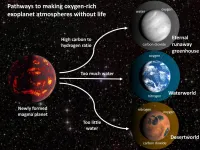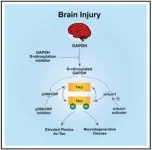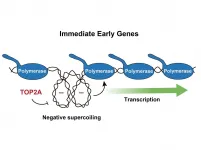(Press-News.org) In the search for life on other planets, the presence of oxygen in a planet's atmosphere is one potential sign of biological activity that might be detected by future telescopes. A new study, however, describes several scenarios in which a lifeless rocky planet around a sun-like star could evolve to have oxygen in its atmosphere.
The new findings, published April 13 in AGU Advances, highlight the need for next-generation telescopes that are capable of characterizing planetary environments and searching for multiple lines of evidence for life in addition to detecting oxygen.
"This is useful because it shows there are ways to get oxygen in the atmosphere without life, but there are other observations you can make to help distinguish these false positives from the real deal," said first author Joshua Krissansen-Totton, a Sagan Fellow in the Department of Astronomy and Astrophysics at UC Santa Cruz. "For each scenario, we try to say what your telescope would need to be able to do to distinguish this from biological oxygen."
In the coming decades, perhaps by the late 2030s, astronomers hope to have a telescope capable of taking images and spectra of potentially Earth-like planets around sun-like stars. Coauthor Jonathan Fortney, professor of astronomy and astrophysics and director of UCSC's Other Worlds Laboratory, said the idea would be to target planets similar enough to Earth that life might have emerged on them and characterize their atmospheres.
"There has a been a lot of discussion about whether detection of oxygen is 'enough' of a sign of life," he said. "This work really argues for needing to know the context of your detection. What other molecules are found in addition to oxygen, or not found, and what does that tell you about the planet's evolution?"
This means astronomers will want a telescope that is sensitive to a broad range of wavelengths in order to detect different types of molecules in a planet's atmosphere.
The researchers based their findings on a detailed, end-to-end computational model of the evolution of rocky planets, starting from their molten origins and extending through billions of years of cooling and geochemical cycling. By varying the initial inventory of volatile elements in their model planets, the researchers obtained a surprisingly wide range of outcomes.
Oxygen can start to build up in a planet's atmosphere when high-energy ultraviolet light splits water molecules in the upper atmosphere into hydrogen and oxygen. The lightweight hydrogen preferentially escapes into space, leaving the oxygen behind. Other processes can remove oxygen from the atmosphere. Carbon monoxide and hydrogen released by outgassing from molten rock, for example, will react with oxygen, and weathering of rock also mops up oxygen. These are just a few of the processes the researchers incorporated into their model of the geochemical evolution of a rocky planet.
"If you run the model for Earth, with what we think was the initial inventory of volatiles, you reliably get the same outcome every time--without life you don't get oxygen in the atmosphere," Krissansen-Totton said. "But we also found multiple scenarios where you can get oxygen without life."
For example, a planet that is otherwise like Earth but starts off with more water will end up with very deep oceans, putting immense pressure on the crust. This effectively shuts down geological activity, including all of the processes such as melting or weathering of rocks that would remove oxygen from the atmosphere.
In the opposite case, where the planet starts off with a relatively small amount of water, the magma surface of the initially molten planet can freeze quickly while the water remains in the atmosphere. This "steam atmosphere" puts enough water in the upper atmosphere to allow accumulation of oxygen as the water breaks up and hydrogen escapes.
"The typical sequence is that the magma surface solidifies simultaneously with water condensing out into oceans on the surface," Krissansen-Totton said. "On Earth, once water condensed on the surface, escape rates were low. But if you retain a steam atmosphere after the molten surface has solidified, there's a window of about a million years when oxygen can build up because there are high water concentrations in the upper atmosphere and no molten surface to consume the oxygen produced by hydrogen escape."
A third scenario that can lead to oxygen in the atmosphere involves a planet that is otherwise like Earth but starts off with a higher ratio of carbon dioxide to water. This leads to a runaway greenhouse effect, making it too hot for water to ever condense out of the atmosphere onto the surface of the planet.
"In this Venus-like scenario, all the volatiles start off in the atmosphere and few are left behind in the mantle to be outgassed and mop up oxygen," Krissansen-Totton said.
He noted that previous studies have focused on atmospheric processes, whereas the model used in this study explores the geochemical and thermal evolution of the planet's mantle and crust, as well as the interactions between the crust and atmosphere.
"It's not computationally intensive, but there are a lot of moving parts and interconnected processes," he said.
INFORMATION:
In addition to Krissansen-Totton and Fortney, the coauthors include Francis Nimmo, professor of Earth and planetary sciences at UC Santa Cruz, and Nicholas Wogan at the University of Washington, Seattle. This research was supported by NASA.
After interviewing various stakeholders from public and private healthcare systems (in Lithuania and the US), researchers Dr Agne Gadeikiene, Prof Asta Pundziene, Dr Aiste Dovaliene from Kaunas University of Technology (KTU), Lithuania designed a detailed structure revealing added value of remote healthcare services, i.e. telehealth. Adopting the concept of value co-creation common in business research to healthcare, the scientists claim that this is the first comprehensive analysis of this kind in the healthcare field involving two different healthcare systems.
According to the researchers, although in the US the consultations via phone with physician have been available for more than fifty ...
A gene therapy protects eye cells in mice with a rare disorder that causes vision loss, especially when used in combination with other gene therapies, shows a study published today in eLife.
The findings suggest that this therapy, whether used alone or in combination with other gene therapies that boost eye health, may offer a new approach to preserving vision in people with retinitis pigmentosa or other conditions that cause vision loss.
Retinitis pigmentosa is a slowly progressive disease, which begins with the loss of night vision due to ...
Violent blows or jolts to the head can cause traumatic brain injury (TBI), and there are currently about five million people in the U.S. living with some form of chronic impairment after suffering a TBI. Even in a mild form, TBI can lead to lifelong nerve cell deterioration associated with a wide array of neuropsychiatric conditions. Tragically, there are no medicines to protect nerve cells after injury. Behind aging and genetics, TBI is the third leading cause of Alzheimer's disease (AD), yet the link between these two conditions is not understood.
In a new study, published online today in Cell, researchers have discovered a new way to prevent brain nerve cells from deteriorating after injury, which also revealed a potential mechanistic ...
AMES, Iowa - Narratives are a powerful tool that can help explain complex issues, but they can also serve as sources of misinformation, which presents a challenge as public health agencies work to educate people about COVID-19 vaccine.
In a paper published by the Proceedings of the National Academy of Sciences, author Michael Dahlstrom, a professor and director of Iowa State University's Greenlee School of Journalism and Mass Communication, examined how narratives or storytelling can help counter misinformation and provide a connection between science and the human experience. Dahlstrom says simply presenting the facts, without some connection, may not help people make ...
Bottom Line: The U.S. Preventive Services Task Force (USPSTF) concludes that the current evidence is insufficient to make a recommendation about screening for vitamin D deficiency in asymptomatic adults. Vitamin D performs an important role in bone metabolism. Requirements may vary by individual and no one blood vitamin D level defines deficiency. The USPSTF routinely makes recommendations about the effectiveness of preventive care services and this recommendation updates and is consistent with its 2014 statement.
To access the embargoed study: Visit our For The Media website at this link https://media.jamanetwork.com/
(doi:10.1001/jama.2021.3069)
Editor's Note: Please see the article for additional ...
New research led by the Garvan Institute of Medical Research has revealed how breast cancer cells that develop during or after pregnancy change their environment to form more aggressive tumours.
In experimental models of pregnancy-associated breast cancer, researchers found that cancer cells send signals to the connective tissue around them to trigger uncontrolled inflammation and remodel the tissue, which in turn helps the cancer to spread.
"Breast cancers that arise during or shortly after pregnancy are highly aggressive as they often become resistant to standard therapies. With 50% of cases ...
Huntington's disease is a genetic neurodegenerative disorder caused by mutations in the protein huntingtin and characterized by involuntary dance-like movements, severe behavioural changes and cognitive impairment. That neuronal traffic is impaired in this disease has been very well known for several years. But that this deranged trafficking could be ameliorated by increasing huntingtin methylation was not yet known. The findings emerged from an international research work coordinated by the University of Trento and published in Cell Reports.
The research teams identified the fundamental role of the protein arginine methyltransferase PRMT6 in ensuring transport along axons, the routes that connect nerve cells to each other, and hence the health of neurons. ...
Researchers from the group of Hans Clevers (Hubrecht Institute) developed the first patient-derived organoid model for cervical cancer. They also modelled the healthy human cervix using organoids. In close collaboration with the UMC Utrecht, Princess Máxima Center for pediatric oncology and the Netherlands Cancer Institute, the researchers used the organoid-based platform to study sexually transmitted infections for a herpes virus. The model can potentially also be used to study the human papillomavirus (HPV), which is one of the main causes of cervical cancer. The results were published in Cell Stem Cell on the 13th of April.
Cervical cancer is a common gynecological malignancy, often caused by the human papillomavirus (HPV). However, good models to study human ...
(Boston)--How could studying gastrointestinal cells help the fight against COVD-19, which is a respiratory disease? According to a team led by Gustavo Mostoslavsky, MD, PhD, at the BU/BMC Center for Regenerative Medicine (CReM) and Elke Mühlberger, PhD, from the National Emerging Infectious Diseases Laboratories (NEIDL) at Boston University, testing how SARS-CoV-2 affects the gut can potentially serve to test novel therapeutics for COVID-19.
In order to study SARS-CoV-2, models are needed that can duplicate disease development in humans, identify potential targets and enable drug testing. BU researchers have created human induced pluripotent stem cells (iPSC)-derived intestinal organoids or 3-D models that can be infected and replicated ...
The (when stretched) two-metre-long DNA molecule in each human cell is continuously being unpacked and packed again to enable the expression of genetic information. When genes must be accessed for transcription, the DNA double helix unwinds and the strands separate from each other so that all the elements needed for gene expression can access the relevant DNA region. This process results in the accumulation of DNA supercoiling that needs to be resolved. A study recently published by Felipe Cortés, Head of the Topology and DNA Breaks Group at the Spanish National Cancer Research Centre (CNIO), and the members of his team, in cooperation with Silvia Jimeno González, Professor ...





